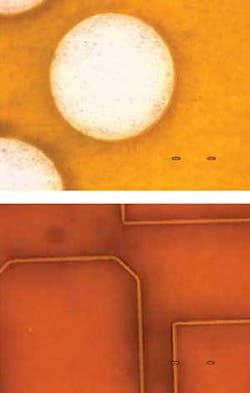UV laser ablation/cutting system cuts stencils for the electronics industry
Stephan Schmidt
Early laser cutting systems that were used to cut metals provided enough power to melt the material, which was then blown away by an assist gas. Typically these were CO2 lasers (10.6 µm, in the far-IR or IR region) with a relatively large beam. Later systems were designed around Nd:YAG lasers (1064 nm, near-IR), pumped with power-hungry flashlamps that provided smaller beams that allowed cutting of greater details (kerf width of <40 µm). But these lasers typically provided less power and therefore only were used to cut thinner metal sheets, for example, stainless-steel stencils for printing solder on circuit boards for surface-mount technology. LPKF Laser & Electronics has been producing many of these systems for this application.
Figure 1. Absorption of metals and insulators
To improve the solder-printing process and other laser based processes for the electronics industry, LPKF has developed a laser system that can cut or ablate organic materials, such as polyimide, flexible circuits, cover layer, overcoats, and solder mask. The system uses a Nd:YAG laser, the output of which is frequency-tripled, resulting in a laser beam of 355 nm (UV). A benefit of the shorter wavelength is a significantly smaller beam size that allows cutting of finer details with a kerf <20 µm, depending on the material and the required power.
Instead of using flash- or arc lamps, this laser system uses diodes as a light source, which is a much more efficient method and reduces the overall power consumption. Therefore, no large cooling system is required to maintain constant temperature of the laser cavity.
Laser ablation/cutting basics
In the ablation process the material is destroyed into dust with minimal heating of the surrounding material. This process leaves a minimum of molten or charred residue behind depending on the material, which means that when processing flex circuits, for example, no resistive residue (carbonized plastic) is left behind, and the quality of ablation/cutting is excellent.
The processing speed of laser cutting/ablation and the resulting cut quality depend on both the characteristics of the material being processed and the nature of the laser emission (wavelength, fluence, peak power, pulsewidth, and pulse rate). It is important to know the absorption characteristic of the material to be cut. Most insulators do absorb radiation in the UV and in the far-IR region (see Figure 1).
Q-switched, frequency-tripled, diode-pumped Nd:YAG lasers emitting a wavelength of 355 nm are the right choice for applications in the circuit-board (especially flex circuits) build and assembly processes, as copper and polyimide can readily be cut or ablated with UV lasers. When employing Q-switching, the lower amplitude tail end of the laser pulse is removed, yielding shorter optical laser pulses in the range of a few tens of nanoseconds, with higher average peak power in the range of a few kilowatts.
The process of photon absorption and material removal takes place in the following way (see Figure 2). Incident photons from the laser beam are absorbed in a thin layer of the material, up to the optical penetration depth. The thickness of the layer lα where most of the energy is absorbed is determined by the wavelength dependent absorption coefficient α: lα=α1
It describes the depth, down to where the intensity of the absorbed radiation has decreased to 1/e. The energy is subsequently transformed into heat and transferred to the molecule chains. When the evaporation temperature of the material is exceeded, the surface material explosively evaporates and leaves the cutting kerf.
The heat also diffuses from the surface layer into the material. The thermal diffusion distance is a function of the material specific diffusion coefficient D, as well as the laser-beam dwell time τL (basically equivalent to the laser pulse length) and describes the distance to where the temperature decreases to 1/e: lw=2 ( D•)12
Figure 2. Process of photon absorption and ablation
To improve cutting quality, the thermal influence (dissipation of the local heat) on the material has to be reduced; that is, this HAZ has to be kept as small as possible.
The two parameters, optical and thermal penetration depth, provide a good estimation of how much thermal influence is involved in the cutting process. The smaller both parameters are and the smaller the thermal penetration depth is compared to the optical penetration depth, the more the energy is confined to a small volume that increases the thermal gradient and thus the cutting quality. Whereas the optical penetration depth is a material-specific constant, the thermal penetration depth increases with longer pulse lengths and can be reduced by using short-pulse lasers.
When the vapor plume leaves the kerf under high pressure, additional heating of the material and a precipitation of debris occurs. Both reduce the cutting quality through beam scattering. Laser debris can be reduced by decreasing the ablated volume, for example.
Figure 4. Cutting speeds vs. material thickness in Kapton
To reduce the thermal losses in the cutting area and therefore heating within the adjacent material, low pulse-repetition rates, high cutting speeds, or a combination can be used. This will result in a longer cooling phase between the pulses and a shorter interaction time between the laser and the material. Even multiple passes with a lower power setting and a delay time between each pass to allow cooling of the material can help reduce the heat-affected zone (see Figures 2 and 3).
Ablation is often used to remove layers of material, so to cut through a sample, multiple passes might be necessary. This also increases control over the amount of heat being generated by each pass and thereby the quality (cleanliness) of the cut. The ablation process can be used for metals, too, but with today’s equipment the processing time is significantly longer compared to older systems, making this process useful only for very thin metal sheets and for organic-based material.
To accomplish ablation in metals it is necessary to increase the peak power density, which can be done by increasing the power, reducing the beam size, or for the same power reducing the laser pulsewidth. A significant factor in the calculation of the theoretical minimum beam size is the laser wavelength, and therefore ablation can be accomplished more easily with shorter wavelengths. Although in laboratory settings many of these improvements have been demonstrated with very short wavelengths and femtosecond pulsewidths, for practical and economic reasons it is necessary to choose and make an acceptable compromise.
Applications
Such a system has been installed at the A-Laser division of Fine Line Stencil in Beaverton, OR, where it is used to cut polyimide stencils. Good paste release from the stencil depends on the ratio of the area of the opening in the stencil, representing the extraction force, to the wall area of the opening, representing the friction force, which keeps the paste in the stencil. But as Kapton provides very little friction, paste release is excellent.
Figure 5. When cutting cover layers (polyimide or Kapton), the kerf width is 30 µm and the cutting speed is 95 mm/s.
As mentioned previously, the speed of cutting depends on the thickness of the material (see Figure 4). The laser systems also are used to cut components out of polyimide (for flex circuits and/or cover layers), mylars, adhesives, prepregs (for cirtuit boards), thin metals up to 75 µm, and are used to ablate solder mask, circuit board layers, and other materials. This system is particularly useful in instances when there are tolerances or shape details that can not be manufactured with traditional milling or CO2 lasing processes. Most of these parts can be cut with size tolerances of less than 6 µm. The positional accuracy is 25 µm or better over a 600x600mm working area.
As these varying materials have different ablation properties, it is necessary to develop specific settings (tools) for each. Even different thicknesses require different tools. And with higher cut-quality requirements, cutting speed has to be adapted. However, the software that is part of the system makes evaluating and changing settings a relatively easy task (see Figure 5).
To allow fast and precise table movement linear motors are used. For movement in a small area (50x50 mm), the laser beam is deflected by a precision galvo system. For the system to maintain its accuracy, it is necessary to operate it in a room having constant temperature. A glass scale and built-in calibration procedures allow for high precision at all times. Other than power (three phase, 400 Vac), it only needs high air pressure (>8 bar) to operate. As this is a diode-pumped system with long-life diodes, the maintenance has been reduced significantly.
Stephan Schmidt is president LPKF Laser & Electronics North America, Wilsonville, OR; www.lpkfusa.com.




